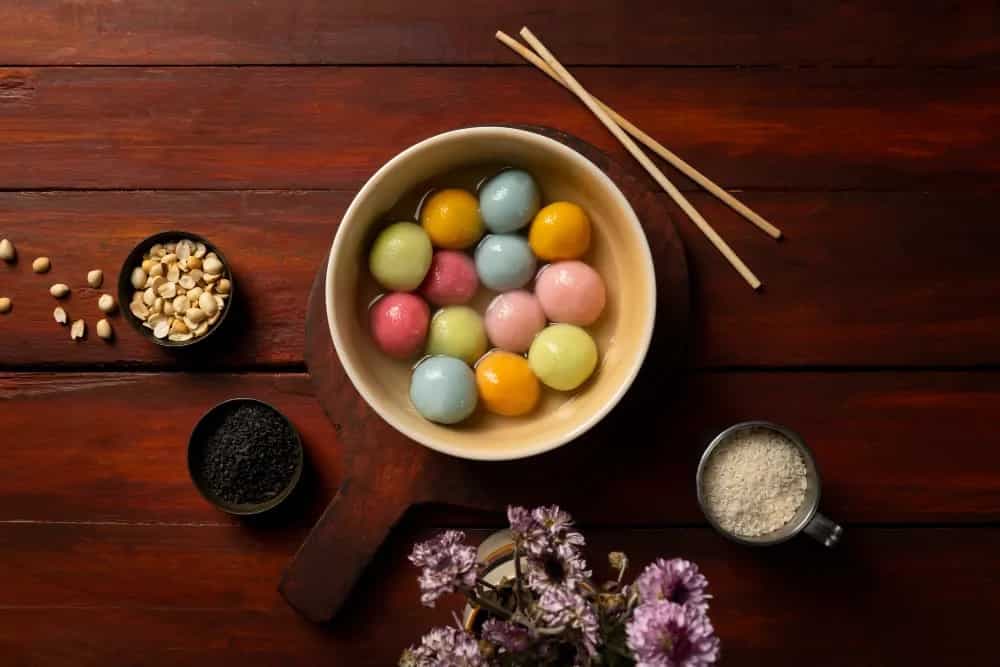It would be easy to mistake a picture of a bowl of the Chinese tangyuan for our very own rosogolla. In appearance, there is little that differentiates one from the other. Like the rosogolla, the tangyuan too comprises small dough balls — as small as a marble or as large as a ping-pong ball — submerged in a syrup. And yet, the two dishes are very different.
This becomes apparent when you consider what the tangyuan is made of — glutinous rice flour kneaded gently with a little warm water. This is just the outer wrapping, which takes on a soft, chewy and slippery texture when cooked. The water in which the tangyuan is boiled is usually a thin, ginger and rock sugar-infused syrup.
The tangyuan wrappers are mostly white in colour, but the rice flour can be kneaded with food dye or natural colours (such as from beetroot juice or pandan leaves) added to the dough to impart a delightful range of hues to the dumplings. These colours too hold certain significance: white means kinship, red stands for joy, pink - love, yellow for wealth and green for health, blue for professional success, and purple for wisdom.

Beyond the dough wrapper, the tangyuan contains its true treasure within: a sweet, nutty and semi-liquid filling. The most common fillings have either peanuts or toasted black sesame seeds mixed with a helping of sugar and lard. However, variations abound as people have moved towards fruits, jam, chocolate, pumpkin seeds, red bean paste and a whole lot more for their tangyuan fillings. Its consistency is key, so tangyuan is always served in a bowl with a spoonful or two of the hot syrup it has been boiled in: in this way, the filling remains gooey as you eat it.
Tangyuan needn't always be sweet: they can be savoury too. In which case, the filling uses horseradish or meat, and the dumplings are boiled in a delicately flavoured soup or broth. This harks to the direct translation of "tangyuan" into English: "soup balls". However, in Chinese, the pronunciation for tangyuan is a homonym for the phrase (tuan yuan) that means "togetherness" or "reunion", and so the dish occupies pride of place at festive celebrations like the Chinese New Year and Lantern Festival in February, but also other joyous occasions like birthdays and weddings, as well as during Dongzhi in December — the winter solstice festival.
There are a couple of origin stories tracing the tangyuan's early iterations. One fable credits the sweet's present status to a young maiden who lived during the Han dynasty, and was pressed into service at the imperial palace. She yearned to visit her family, residing in a far-flung province, but according to the palace's rules, this seemed well nigh impossible. A kindly minister at court observed her homesickness and suggested a solution. He advised her to prepare the best possible tangyuan she could and serve it to the Emperor and Empress. If they were impressed with her dessert, they might be inclined to grant her leave to visit home.
The maid — whose name was Yuan Xiao — followed the minister's advice and prepared a batch of beautifully formed, coloured and flavoured tangyuan. The Emperor was pleased with her efforts, and told Yuan Xiao she would be granted a wish. When she expressed her heartfelt yearning to return home, she was immediately given royal permission to do so. And so it is that tangyuan became synonymous with the idea of homecomings, family and togetherness.

Now, there is a dish that is actually called "yuan xiao", which is considered the tangyuan's northern sibling (or according to some sources, the very same dish). However, it differs from the tangyuan in preparation, fillings and so on. An apocryphal story holds that the Chinese leader Yuan Shikai decreed that the name of the sweet be changed from yuan xiao to tangyuan, as the former sounded too similar to "remove Yuan" in Chinese.
Yet another origin tale ascribes the dish's existence to the Qing era, when Emperor Qianlong lost his way during a journey south of the River Yangtze. Separated from his entourage, he stumbled into a village and sought assistance at an old woman's hut. With only a little glutinous rice flour at home (and some black sesame), the woman was at a loss until she hit upon the idea of wrapping sesame paste in a dough made of the rice flour. These dumplings she boiled in water and served to Qianlong. When the Emperor asked the old woman what the dish was called, she responded: "tangyuan".


